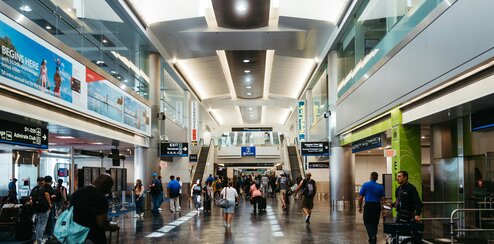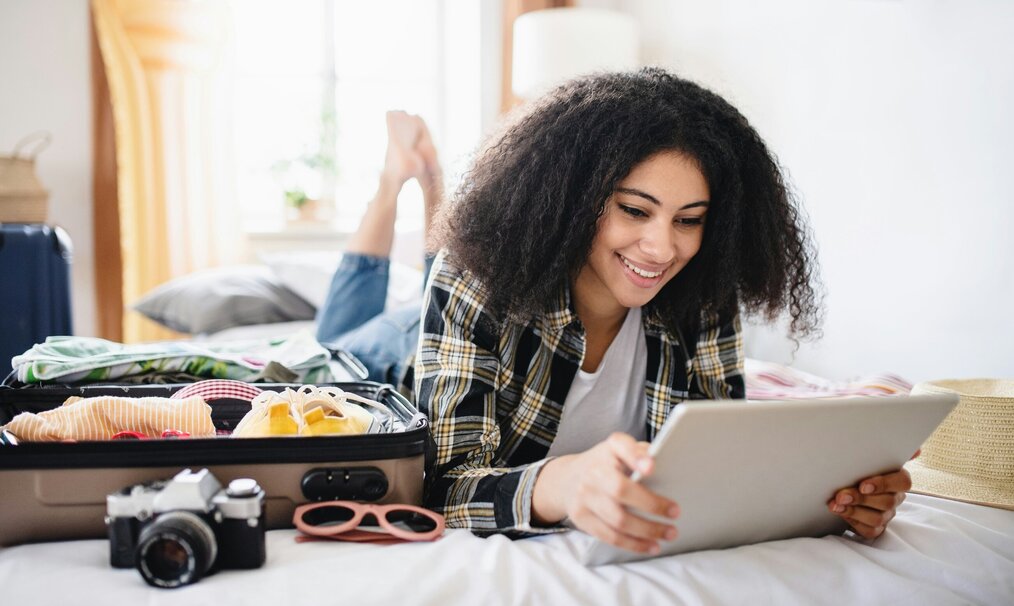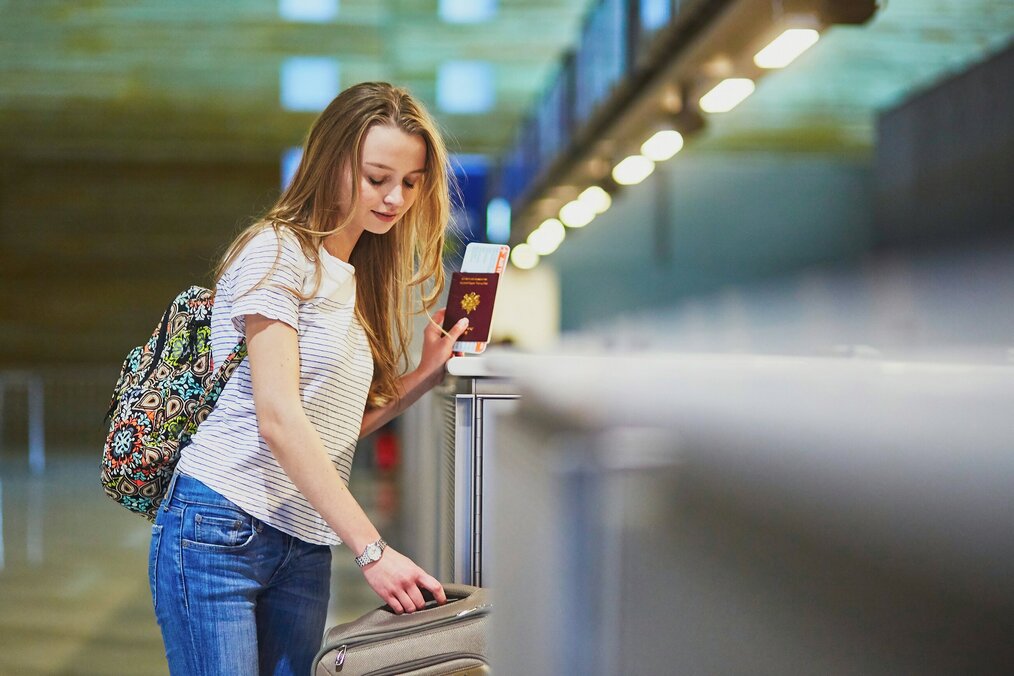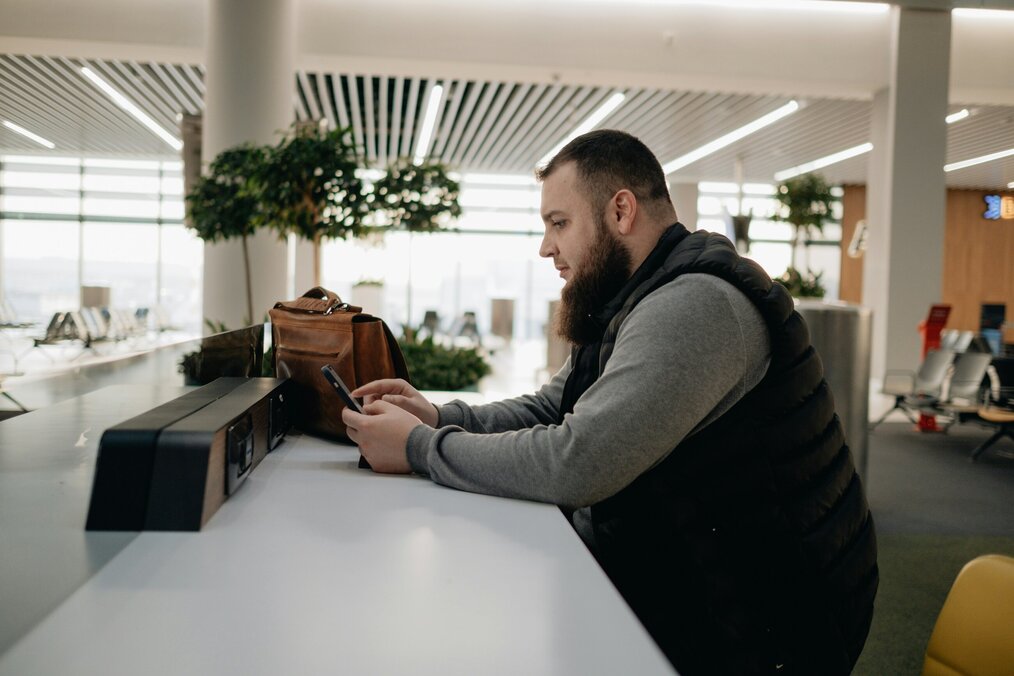
10 Airport Tips & Tricks for Stress-Free Travel
Travel like a pro with these 10 airport tips and tricks that will make your next trip a breeze.
Meaningful travel experiences like studying abroad, volunteering, taking a gap year, or teaching overseas often start and end with an international flight. Airports and air travel can be stressful and confusing for new and seasoned travelers alike, though. With all the steps to navigate, rules, and the need to get the timing down just right, flying can quickly become overwhelming without a little help.
To make your next trip a little smoother, we’ve highlighted 10 helpful airport tips & tricks for stress-free travel!
1. Register for expedited security screening
If you plan on flying frequently, it’s a great idea to get signed up for expedited security screening through TSA PreCheck or Global Entry.
- TSA PreCheck: US citizens and permanent residents pay $85 USD for a five-year pass. According to their website, most people wait less than 10 minutes to get through security. PreCheck only applies for flights departing US airports and can not be used at airports abroad or for reentry to the States. Approval time usually takes 3-5 days but can take up to 60 days for some applications.
- Global Entry: Global Entry speeds up the reentry to the US for US citizens as well as citizens from certain countries including Mexico, the UK, Germany, Taiwan, Panama. Due to the rigorous background check that Global Entry requires, approval can take anywhere from 2 weeks to 6 months. You’ll pay a one-time fee of $120 USD with your application.
2. Download your airline’s app and check-in online
Even if you feel like you already have a million apps chaotically crowding your phone, downloading your airline’s app is an important addition. The perks of airline apps include:
- Saves time: If you aren’t checking any bags, you can go straight to security!
- May allow you to choose your seat: Optimize your legroom by securing an emergency exit seat or get that window seat you want.
- Gives you easy access to boarding passes: Screenshot it or add it to Apple Wallet so there’s no chance of misplacing it.
- Allows you to check for flight delays: Get notified about status changes and gate changes.
If you don’t plan on flying with the airline regularly, you can delete the app after your trip.
3. Pack your carry-on strategically

Packing a carry-on bag is both an art and a science. You’ll not only want to make sure you have the right items but also that they’re packed in a way that makes them easy to get to.
- Empty water bottle
- Travel pillow, blanket, or sweatshirt/sweater
- Medication with prescriptions
- Snacks
- Group electronics, chargers, and cables in packing cube
- Place electronics and liquids at the top of your carry-on for easy removal when going through screening
- Remember the 3-1-1 rule for liquids
Electronics and liquids should be packed on top in their own separate bags so that you can quickly take them out and repack them after the security screening.
If you’re on a long-haul flight, it’s a good idea to pack a toothbrush, compression socks, earplugs and eye mask, hand sanitizer, facial wipes, and a pen if you need to fill out immigration forms during the flight. Should you want to take something to help you sleep, think about sleep aids like melatonin, which are non-habit-forming and don’t leave you groggy. Always ask your doctors before trying new meds or supplements though!
4. Download entertainment
For some people, flights of any duration are incredibly boring. To keep yourself entertained, don’t forget to download your favorite shows, movies, music, podcasts, and games before you head to the airport. Rather than bringing an e-reader and a tablet, download the Kindle app to have access to your books as well.
Bring a portable power bank in case your battery starts to run low but there’s not an outlet in sight. Remember to put this in your carry-on, not your checked bag!
5. Dress for comfort (and security screening)!
You may want to wear your best outfit so that you look fab when the plane touches down at your destination but comfort is king. Some top tips for staying comfy when flying include:
- Wear loose, breathable layers: Planes are already uncomfortable enough so avoid tight, restrictive, or inflexible fabrics.
- Pick the right shoes: comfortable, easy-to-remove shoes (think slip-on!) are the best pick.
- Avoid lots of accessories: jewelry, belts, scarves, and other accessories take time to remove which can make the security screening way more stressful than it already is. If you need certain items, try to remove them well in advance of the line.
- Store your contacts: For long flights, wearing your glasses will ensure your eyes don’t get irritated by the dry plane interiors. It’s also less hassle than worrying about juggling your contact solution and case mid-flight if you decide to take them out.
A perk of registering for TSA PreCheck is that you don’t have to remove shoes, jackets, or belts during screening so keep that in mind if you’re on the fence!
6. Make sure your documents are readily accessible

When navigating the airport, you may be asked for your passport and boarding pass at various times. Store important documents safely in your carry-on (preferably in a separate pocket that closes/zips) so they don’t get misplaced. If your boarding pass is on your phone, make sure your phone is charged and within reach.
7. Avoid checked baggage if possible
A major time and stress saver is flying with only carry-on items. You can check in online at home before you get to the airport then hop the lines at the airline desks and go straight to security.
Checking bags may be unavoidable, though, if you’re planning to be away for a while. If flying with checked bags is necessary, try to:
- Get to check in early: Arriving earlier than you planned may leave you with extra time sitting by the gate later but it’ll save you the panic of lines that move insanely slow. Remember that bag check-in for international flights is 1 hour and for domestic flights is 45 minutes!
- Mark your bags clearly: Consider adding a ribbon or scarf to the handle of your bag if it’s generic-looking. That’ll help you identify it faster at baggage claim!
8. Bring a reusable water bottle
Bottled water at the airport is crazy expensive (and a waste of plastic). Bring your own reusable water bottle and keep it empty until you get through security. Afterward, you can fill it up at a water fountain or visit the nearest Starbucks for free iced water!
9. Give yourself enough time, but not too much time
The usual recommendation is to arrive at the airport 2 hours before domestic flights and 3 hours before for international. It’s helpful to gauge this time based on your boarding time and not departure time. You can adjust this time based on certain factors like if you checked in online, aren’t checking bags, and are registered for expedited security screening like TSA PreCheck.
Don’t forget to factor in any traffic delays on the way to the airport!
10. Consider airport lounges

Airport lounges aren’t free but they’re great if you have international flights or long layovers. They include perks like Wi-Fi, meals and drinks, plenty of power outlets, and comfy seating. Depending on the airport, some may also have showers which are great for freshening up during extended layovers.
To save some cash, check if your credit card grants lounge access or whether you can purchase a discounted day pass.
Travel safety nets
In addition to the tips above, we think it’s also good to be prepared for anything when you travel. Think about the following options before your next trip!
- Travel insurance: Can protect you in the event of lost or damaged baggage, flight delays and cancellations, and more. GO recommends checking out World Nomads and Safety Wing!
- Travel credit card: Having a credit card you use only for emergencies when you travel can give you extra peace of mind.
- Smart Traveler Enrollment Program The STEP program was created by the State Department to keep US citizens traveling abroad informed of any disasters or emergencies in their destination country. It will also help the State Department contact you should US citizens need to be evacuated or accounted for.
Explore Go Overseas’ nomad essentials
Here at Go Overseas, we love making travel easier! To support your globetrotting lifestyle, we've partnered with a range of major companies to provide you with discounts on things like travel insurance, accommodation, and more. Check out our nomad essentials to stock up on everything you need!
Once you find your groove, navigating airports and taking flights will start to feel like second nature. Air travel is never really completely stress-free but with our tips, you will at least feel prepared to take on anything that comes along!
Continue your travel planning with GO:






